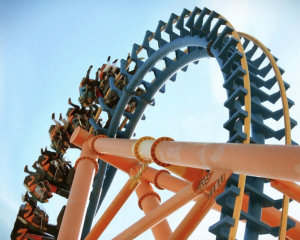So what do we know about roller coasters?
我们对过山车了解多少?
They're fun, they're exciting, they're a little scary, but they're pretty awesome.
它们很有趣,很刺激,也有点吓人,但它们确实让人惊叹。
What else do you need to know? What about how they work?
你还需要了解些什么?它们的工作原理是什么样的?
As complicated as they are, roller coasters rely on some very basic rules of physics.
尽管过山车本身很复杂,但它依赖的其实是一些非常基本的物理规则。
Even though a roller coaster looks like a train, it doesn't have an engine of its own.
虽然过山车看起来像火车,但它没有自己的引擎。
For most of the ride, the roller coaster is powered by gravity and momentum.
过山车运行过程中的大部分时间都是靠重力和动量驱动的。

To build that momentum, you need to get the train to the top of that first hill or give it a powerful launch.
为了创造这种动量,你需要让过山车到达第一个山坡的顶部,或者给它一个强有力的发射。
After the cars get down that first hill, they've built up enough energy to take them up the next hill.
在过山车滑下第一个山坡后,会积累足够的能量冲向下一个山坡。
It's kind of like riding your bike down a steep hill.
这有点像骑自行车从陡峭的山坡上冲下来。
The longer or steeper the hill, the faster you go.
山坡越长越陡,那么你的速度就越快。
That's why each hill on a roller coaster is usually just a little bit smaller than the one before.
这就是为什么在过山车运行过程中,每个山坡通常都比前一个要小一点。
If the second hill were taller, the cars wouldn't be able to build up enough momentum to make it to the top.
如果第二个山坡更高一点,那么过山车就无法积累足够的动量登顶了。











